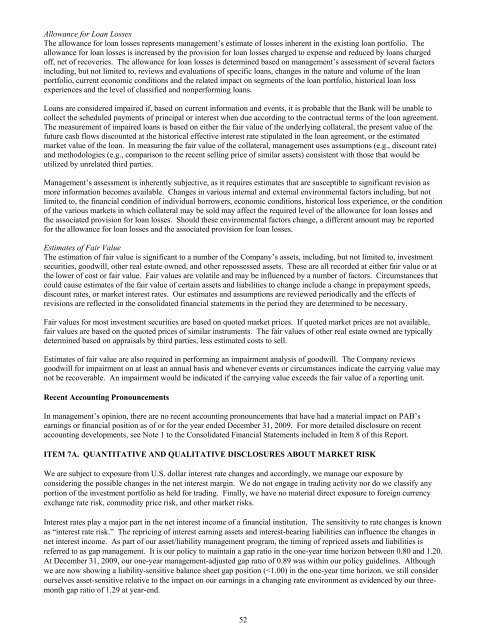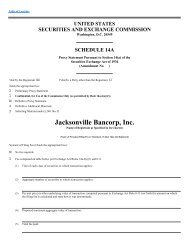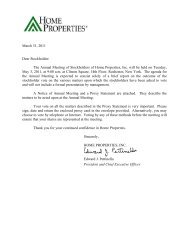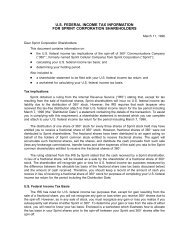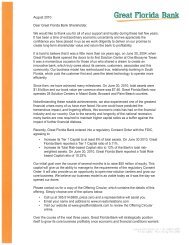pab bankshares, inc. - SNL Financial
pab bankshares, inc. - SNL Financial
pab bankshares, inc. - SNL Financial
Create successful ePaper yourself
Turn your PDF publications into a flip-book with our unique Google optimized e-Paper software.
Allowance for Loan Losses<br />
The allowance for loan losses represents management’s estimate of losses inherent in the existing loan portfolio. The<br />
allowance for loan losses is <strong>inc</strong>reased by the provision for loan losses charged to expense and reduced by loans charged<br />
off, net of recoveries. The allowance for loan losses is determined based on management’s assessment of several factors<br />
<strong>inc</strong>luding, but not limited to, reviews and evaluations of specific loans, changes in the nature and volume of the loan<br />
portfolio, current economic conditions and the related impact on segments of the loan portfolio, historical loan loss<br />
experiences and the level of classified and nonperforming loans.<br />
Loans are considered impaired if, based on current information and events, it is probable that the Bank will be unable to<br />
collect the scheduled payments of pr<strong>inc</strong>ipal or interest when due according to the contractual terms of the loan agreement.<br />
The measurement of impaired loans is based on either the fair value of the underlying collateral, the present value of the<br />
future cash flows discounted at the historical effective interest rate stipulated in the loan agreement, or the estimated<br />
market value of the loan. In measuring the fair value of the collateral, management uses assumptions (e.g., discount rate)<br />
and methodologies (e.g., comparison to the recent selling price of similar assets) consistent with those that would be<br />
utilized by unrelated third parties.<br />
Management’s assessment is inherently subjective, as it requires estimates that are susceptible to significant revision as<br />
more information becomes available. Changes in various internal and external environmental factors <strong>inc</strong>luding, but not<br />
limited to, the financial condition of individual borrowers, economic conditions, historical loss experience, or the condition<br />
of the various markets in which collateral may be sold may affect the required level of the allowance for loan losses and<br />
the associated provision for loan losses. Should these environmental factors change, a different amount may be reported<br />
for the allowance for loan losses and the associated provision for loan losses.<br />
Estimates of Fair Value<br />
The estimation of fair value is significant to a number of the Company’s assets, <strong>inc</strong>luding, but not limited to, investment<br />
securities, goodwill, other real estate owned, and other repossessed assets. These are all recorded at either fair value or at<br />
the lower of cost or fair value. Fair values are volatile and may be influenced by a number of factors. Circumstances that<br />
could cause estimates of the fair value of certain assets and liabilities to change <strong>inc</strong>lude a change in prepayment speeds,<br />
discount rates, or market interest rates. Our estimates and assumptions are reviewed periodically and the effects of<br />
revisions are reflected in the consolidated financial statements in the period they are determined to be necessary.<br />
Fair values for most investment securities are based on quoted market prices. If quoted market prices are not available,<br />
fair values are based on the quoted prices of similar instruments. The fair values of other real estate owned are typically<br />
determined based on appraisals by third parties, less estimated costs to sell.<br />
Estimates of fair value are also required in performing an impairment analysis of goodwill. The Company reviews<br />
goodwill for impairment on at least an annual basis and whenever events or circumstances indicate the carrying value may<br />
not be recoverable. An impairment would be indicated if the carrying value exceeds the fair value of a reporting unit.<br />
Recent Accounting Pronouncements<br />
In management’s opinion, there are no recent accounting pronouncements that have had a material impact on PAB’s<br />
earnings or financial position as of or for the year ended December 31, 2009. For more detailed disclosure on recent<br />
accounting developments, see Note 1 to the Consolidated <strong>Financial</strong> Statements <strong>inc</strong>luded in Item 8 of this Report.<br />
ITEM 7A. QUANTITATIVE AND QUALITATIVE DISCLOSURES ABOUT MARKET RISK<br />
We are subject to exposure from U.S. dollar interest rate changes and accordingly, we manage our exposure by<br />
considering the possible changes in the net interest margin. We do not engage in trading activity nor do we classify any<br />
portion of the investment portfolio as held for trading. Finally, we have no material direct exposure to foreign currency<br />
exchange rate risk, commodity price risk, and other market risks.<br />
Interest rates play a major part in the net interest <strong>inc</strong>ome of a financial institution. The sensitivity to rate changes is known<br />
as “interest rate risk.” The repricing of interest earning assets and interest-bearing liabilities can influence the changes in<br />
net interest <strong>inc</strong>ome. As part of our asset/liability management program, the timing of repriced assets and liabilities is<br />
referred to as gap management. It is our policy to maintain a gap ratio in the one-year time horizon between 0.80 and 1.20.<br />
At December 31, 2009, our one-year management-adjusted gap ratio of 0.89 was within our policy guidelines. Although<br />
we are now showing a liability-sensitive balance sheet gap position (


